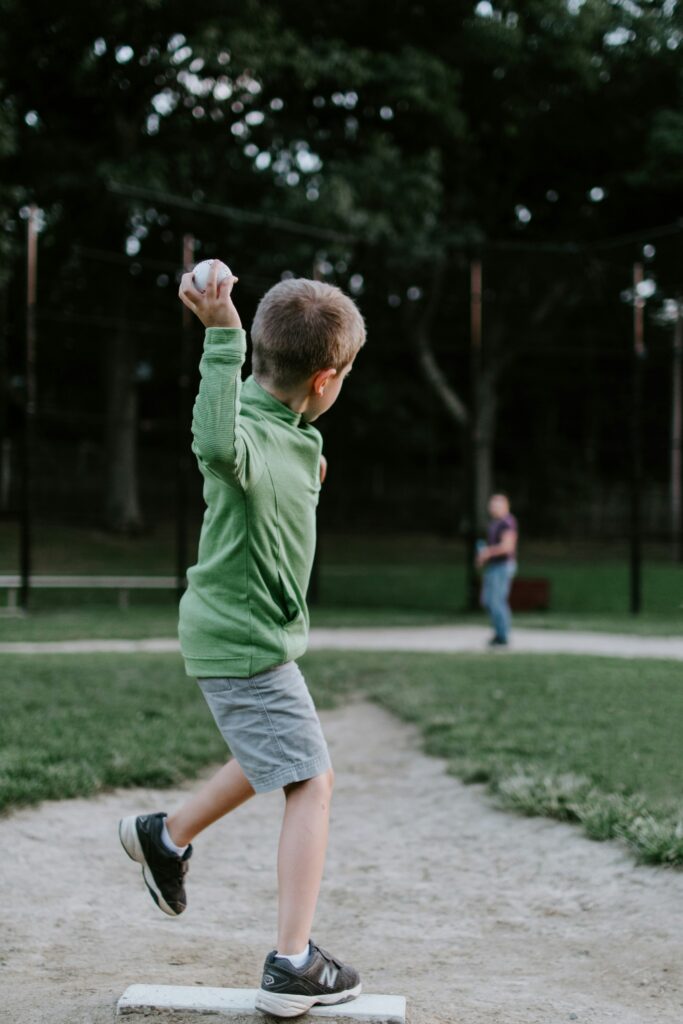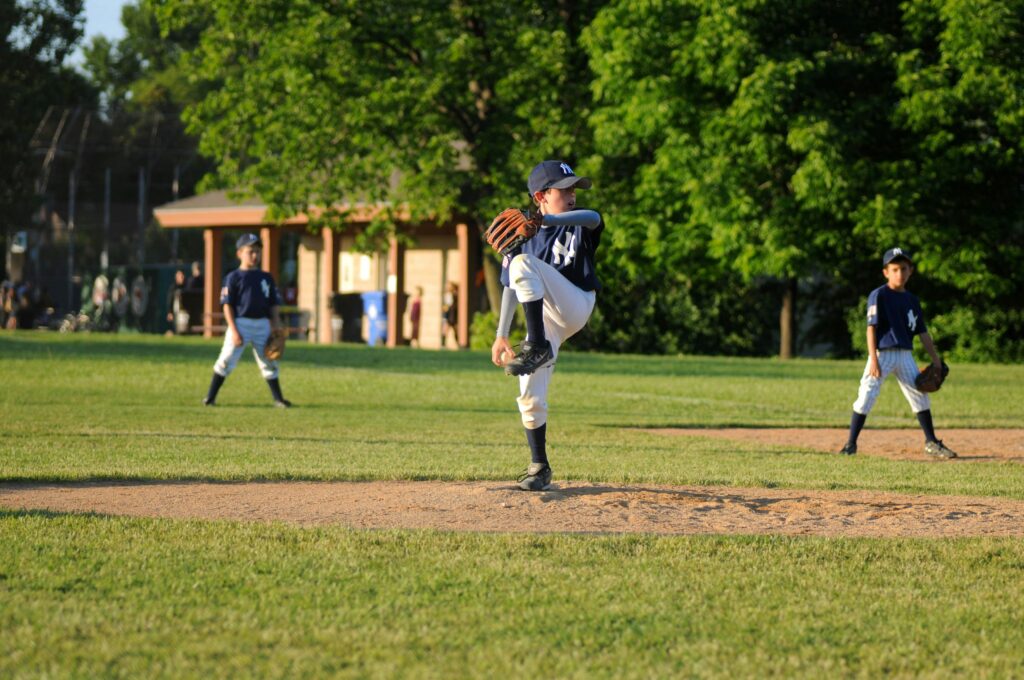Baseball isn’t all about learning how to swing, hit home runs, and fielding ground balls. In baseball, the ability to throw harder can be a game-changer, offering a significant advantage especially as a little leaguer. Often times at practice coaches spend extra time teaching our kids to hit and field ground balls, but it’s easy for you as a parent to grab a your kid and teach them to make quick, accurate throws. Increasing throwing velocity requires more than just raw strength (most of our young little leaguers still don’t have raw strength anyway)—it demands proper mechanics, physical conditioning, and mental preparation. So as your little little leaguer is playing a whole lot of catch and breaking-in their new glove, a bit of extra focus can help them begin to throw the baseball harder. In this article, we explore why throwing harder matters and how you can improve your velocity through technique, strength training, drills, and mental strategies.

Why Does Throwing Harder Matter?
Throwing harder is a game-changer in baseball because it forces opponents to react more quickly, giving you a competitive edge. A fast throw limits a batter’s or baserunner’s time to adjust, increasing the likelihood of making a successful play. Beyond the immediate gameplay advantages, throwing velocity is a critical factor that you’ll constantly work one no matter what level of baseball your competing in. However, achieving higher velocity isn’t just about raw strength; it requires mastering proper mechanics, developing core stability, and harnessing explosive power. By refining your technique and building strength strategically, you can consistently elevate your performance.

What Are the Key Mechanics for Throwing Harder?
Throwing a baseball might seem simple, but every great throw starts with a solid foundation of proper mechanics. From how you grip the ball to the way you follow through, each step plays a critical role in achieving accuracy, power, and consistency. Whether you’re honing your fastball or perfecting your breaking pitch, understanding and refining these key elements can elevate your game to the next level. Let’s break down the essential components of a great throw and how to execute them effectively.
Grip
The grip is the foundation of your throw. By placing your index and middle fingers across the seams of the baseball, you create optimal friction, which enhances both control and spin. This technique allows you to command the ball’s movement more effectively, whether you’re throwing a fastball or a breaking pitch. A proper grip also reduces slippage, ensuring consistent accuracy and velocity.
Arm Path
A fluid and straight arm path is essential for efficient energy transfer. Avoid unnecessary movements or “short-arming,” which can reduce power and increase the risk of injury. Instead, focus on a full, natural arm swing that allows momentum to build from your legs through your torso and into your throwing arm. Consistency in your arm path is key to delivering powerful and accurate throws.
Body Alignment
Proper body alignment sets the stage for a strong, accurate throw. Starting sideways to the target allows you to engage your core and hips, creating rotational power as you uncoil during the throw. This alignment not only boosts velocity but also ensures that your entire body contributes to the motion, reducing strain on your arm.
Stride
Your stride is where momentum begins. Taking a strong, deliberate step with your lead foot pointed toward the target helps channel energy from your lower body into the throw. A well-executed stride creates balance and stability, giving you a solid base to generate maximum power while maintaining accuracy.
Follow-Through
A complete follow-through is the finishing touch that maximizes velocity and protects your arm. Fully extending your arm toward the target ensures that all the energy generated during the throw is effectively transferred to the ball. Skipping the follow-through can lead to a sudden deceleration, increasing the risk of arm injuries. By allowing your arm to continue its motion naturally, you achieve a smoother, more powerful throw.

How Can Strength Training Improve Your Throw?
To throw with power, accuracy, and consistency, you need more than just a good grip or arm path—you need a well-conditioned body. The key to enhancing your pitching mechanics lies in developing strength, power, and flexibility throughout your entire body. From the explosive power of your legs to the rotational torque of your core and the stability of your upper body, each muscle group plays a critical role in delivering a strong, injury-free throw. Let’s explore how building strength in these areas can help you elevate your pitching performance and stay at your best on the mound.

Lower Body Strength
Building lower body strength is essential for generating power and stability in your throw. Squats and lunges are foundational exercises that target the muscles in your legs, hips, and glutes, all of which play a crucial role in your pitching mechanics. Strong legs help propel your body forward during the stride, creating momentum and transferring energy to your arm. Consistent lower body training ensures a solid base that supports your throwing motion and enhances overall performance. Even the youngest little leaguers can warm up with some lunges before throwing the baseball.
Core Power
Your core is the powerhouse that drives rotational movements, making it vital for effective pitching. Planks, rotational exercises, and medicine ball drills are excellent for strengthening the muscles of your torso, improving your ability to generate torque. These exercises engage the obliques, lower back, and abs, which are key in transferring energy from your lower body to your upper body. A strong core allows for more explosive rotation and greater control during your throw, leading to better velocity and accuracy.
Upper Body Strength
Upper body strength, particularly in the shoulders, arms, and chest, is crucial for pitching. Push-ups, bench presses, and resistance band exercises help build the muscle groups that stabilize your shoulder and support your throwing arm. Even at 6 years old, I would encourage my son to do 3 sets of 10 push-ups before we threw the ball around. Strengthening the rotator cuff muscles, in particular, prevents injury and improves throwing endurance. These exercises also contribute to more powerful and controlled throws, as a stable shoulder is necessary for transferring the force generated in your lower body into the ball.
Explosive Movements
As your little leaguer gets older, explosive movements like box jumps and medicine ball slams activate fast-twitch muscle fibers, which are responsible for quick, powerful actions. These exercises train your body to generate explosive power in short bursts, a key component of a high-velocity throw. By incorporating plyometrics into your routine, you improve your ability to produce quick, dynamic movements during your pitching delivery, allowing you to throw harder and with greater speed.
Flexibility
Flexibility is essential for maintaining fluid, injury-free motion. Dynamic stretches help loosen up your muscles and improve range of motion, allowing for a smoother throwing motion. Focusing on your rotator cuff muscles with targeted exercises ensures that your shoulder stays healthy and mobile. Flexibility also contributes to better mechanics, as it allows your body to move freely and efficiently through each phase of the throw, reducing strain and maximizing your overall performance.
What Drills Can Help You Throw Harder and Farther?
To take your throwing game to the next level, incorporating a variety of targeted training methods is essential. Whether you’re focusing on building arm strength, improving your mechanics, or mastering specific techniques, each component plays a crucial role in your development as a player. From long toss programs that build endurance and velocity to flat ground drills that refine your technique, these exercises will help you become more effective on the field. Let’s dive into some key training strategies that will boost your throwing power, accuracy, and overall performance.
Long Toss
long toss is essential for developing both arm strength and endurance over time. By gradually increasing the throwing distance, you allow your arm to adapt and strengthen without overloading it too quickly. Long toss helps improve the velocity and stamina of your throws by working out the muscles in your arm, shoulder, and core. Long toss also enhances your ability to throw longer distances consistently, making you more effective on the field. As you build up endurance, you’ll notice better overall arm health and an increase in your maximum throwing velocity.
Flat Ground Throws
Flat ground throws provide an excellent opportunity to focus solely on your throwing mechanics in a controlled environment. By practicing without the pressure of distance or velocity, you can fine-tune your technique, ensuring that every aspect of your motion is efficient. Flat ground drills help you maintain proper posture, arm path, and body alignment. They also give you the chance to work on specific areas, such as accuracy or follow-through, without the added challenge of elevation or wind. Perfecting your mechanics in this setting is key to ensuring consistency and improving overall performance.
Crow Hop Technique
The crow hop technique is a powerful tool for outfielders who need to maximize their throwing distance. By using a quick hop to generate forward momentum, you transfer the energy from your lower body into the throw, allowing you to launch the ball further and with more velocity. This technique requires timing and coordination, as the hop should be smooth and quick to ensure maximum efficiency. Practicing the crow hop will not only increase the distance of your throws but also help you cover more ground and make impressive plays from the outfield.
My dad had me practice my crow hop endlessly, and I can’t even count how many baserunners I threw out at home plate from center field. Being on the shorter and smaller side compared to others my age, the crow hop gave me that extra burst of power I needed to get the ball to the plate as quickly as possible. It was a game-changer, helping me make those big plays that made all the difference.
Quick Transitions
For infielders, quick transitions are critical for making fast, accurate plays. Practicing rapid glove-to-throw moves ensures that you can get the ball out of your glove quickly and into your throw, reducing the time it takes to complete a play. Footwork is equally important; sharp, agile movements allow you to position yourself for the best throw possible. Ladder drills are an excellent way to improve foot speed and coordination, enabling you to move quickly and efficiently. By mastering quick transitions and footwork, you can improve your defensive capabilities and make game-changing plays.
Weighted Ball Training
Weighted ball training is a method used to safely build arm strength and velocity by incorporating slightly heavier balls into your throwing routine. When used correctly and under supervision, weighted balls can help increase the force you generate during each throw. These exercises engage the muscles in your arm, shoulder, and core, promoting muscle growth and improving overall throwing power. However, it’s important to use proper form and avoid overexertion to reduce the risk of injury. With proper guidance, weighted ball training can be a safe and effective way to enhance your throwing mechanics and arm strength.
How Does the Mental Game Enhance Your Throwing?
Achieving peak performance on the field goes beyond physical training—it’s also about cultivating the right mindset and tracking your progress. Techniques like visualization help you mentally rehearse perfect throws, boosting confidence and reducing anxiety, while consistent routines prepare you for success. Tracking your progress through tools like radar guns and video analysis ensures you’re improving and staying on course. Additionally, expert feedback offers personalized insights to refine your technique and enhance your overall performance. Let’s explore how these mental and analytical tools can elevate your game and help you reach your full potential.
Visualization
Visualization is a powerful mental technique that helps you mentally prepare for success. By imagining yourself making perfect throws, you create a positive mental image that boosts confidence and reduces anxiety. This practice allows you to rehearse the mechanics of your throw in your mind, reinforcing proper technique and building muscle memory. Visualization also helps you stay calm under pressure, ensuring you approach each throw with a focused, determined mindset. Consistently using this technique can increase your confidence on the field and improve your overall performance.
Routines
Establishing consistent pre-game and practice routines is key to staying focused and performing at your best. Routines help you mentally prepare for each game or practice session, ensuring that you’re in the right mindset to perform. This could include warm-ups, specific drills, or even mental exercises like visualization. A well-structured routine also keeps you disciplined, helping you stay on track with your goals and prevent distractions. Over time, these habits become second nature, allowing you to focus solely on the game and make the most of your practice time.
Progress Tracking
Tracking your progress is essential for measuring improvements and identifying areas for growth. Tools like radar guns and video analysis provide objective data on your throwing velocity, mechanics, and overall performance. Radar guns allow you to track your speed and monitor increases in velocity, while video analysis lets you review your form and pinpoint areas that need adjustment. Regularly measuring your progress ensures that you’re on the right track and provides motivation to continue working hard toward your goals.

Expert Feedback
Working with experts like coaches or professionals can provide invaluable feedback to take your throwing to the next level. These professionals offer personalized insights based on their experience and expertise, helping you refine your mechanics, identify weaknesses, and avoid injury. By receiving tailored advice and guidance, you can develop a more effective training regimen and address specific areas that need improvement. Expert feedback accelerates your progress and ensures that you’re maximizing your potential while staying healthy.
Final Thoughts
Throwing harder is more than just a physical feat; it’s about mastering the mechanics, building strength, and honing the mental game to enhance your performance. Whether you’re working on your grip, developing core power, or incorporating visualization techniques, every aspect of your training contributes to a stronger, faster throw. By consistently focusing on the fundamentals, tracking your progress, and seeking expert feedback, you can continue to improve your throwing velocity and gain a competitive edge on the field. With dedication and the right approach, throwing harder can be the key to unlocking your full potential in baseball. Check out Coach Dan Bewitt’s video about throwing harder and see what He has to say.

